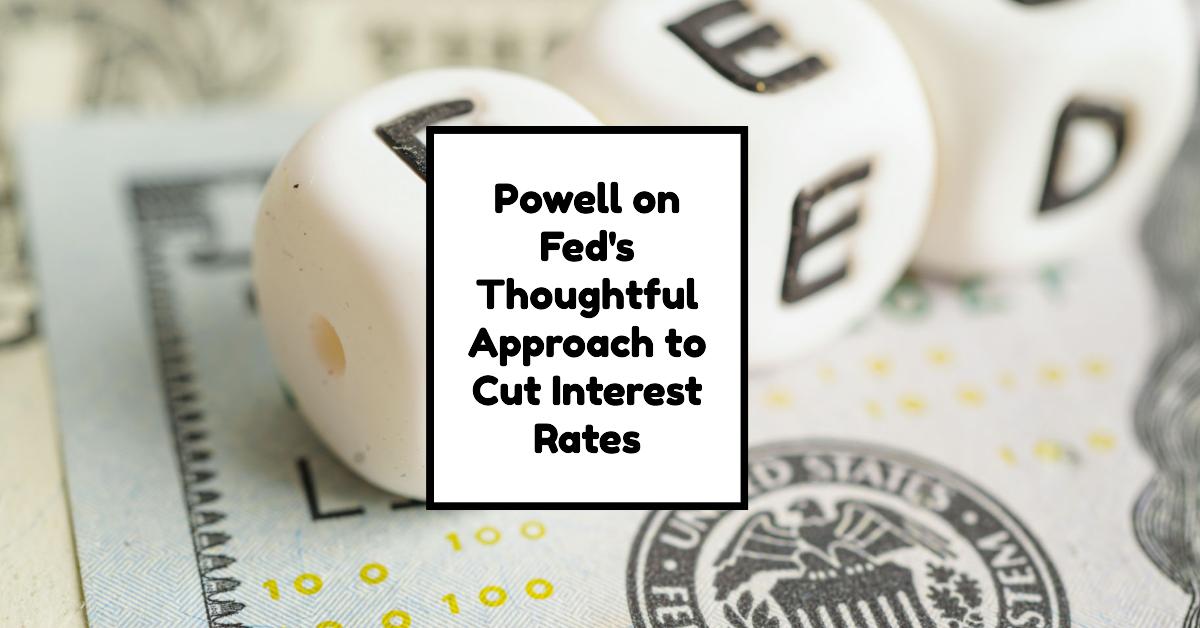In a striking commentary on the current state of the economy, Federal Reserve Chair Jerome Powell reaffirmed that the Federal Reserve is in no rush to cut rates. This perspective reflects a strategic approach aimed at fostering sustained economic growth rather than responding to immediate challenges. Powell's remarks were made during a meeting of the National Association for Business Economics in Nashville and came after the Fed's significant decision to lower its benchmark interest rate earlier this month.
Powell on Fed's Thoughtful Approach to Cut Interest Rates
Key Takeaways
- Strategic Decision: The Fed's recent interest rate cut is not a response to economic distress but rather a proactive measure to ensure economic stability.
- Interest Rate Cut: On September 18, 2024, the Fed reduced the rate by 0.50 percentage points, marking its first cut since 2020.
- Focus on Strength: Powell emphasized the aim of keeping the economy on solid footing and maintaining maximum employment alongside price stability.
- Economic Indicators: The Fed predicts a slight increase in unemployment from 4.2% to 4.4%, supporting the rationale for preemptive action.
- Civil Servants' Role: The Fed’s decision-making is based on various economic indicators, highlighting the complexity of monetary policy.
In an interconnected global economy, the Federal Reserve serves as a crucial pillar of economic stability in the United States. The recent cut in interest rates, decided on September 18, 2024, is a pivotal moment in a delicate balancing act. At 4.75% to 5%, the current benchmark interest rate reflects the Fed’s response to economic data and forecasts regarding inflation and employment trends. Powell's remarks signal a commitment to not prematurely cut rates unless there is a clear necessity. This cautious approach aims to support a robust job market while keeping inflation in check.
Understanding Powell's Perspective
During his address, Powell underscored that the decision to cut interest rates should not be misconstrued as evidence of a struggling economy. Instead, he framed it as a method to ensure that a strong economy remains stable. By reducing borrowing costs, the Fed aims to stimulate economic growth and encourage spending without triggering a surge in inflation. The cut was a historical milestone, being the first since 2020 and occurring at a time when the economy showed signs of resilience despite challenges such as inflationary pressures and a softening labor market.
The Economic Landscape
Inflation has complex implications for the economy. Since the beginning of 2024, inflation rates have remained stubbornly high. The core inflation rate, which excludes volatile food and energy prices, has hovered around the Fed's target goal of 2% per year. However, persistent pressures from demand-side factors and supply chain constraints have prevented inflation from easing significantly. Understanding this backdrop is crucial when evaluating the Fed's commitment to maintaining low rates for the foreseeable future.
Powell’s remarks encapsulate a sentiment echoed by other Fed officials who also advocate for patience. The philosophy driving this approach is not to create an environment where economic recovery feels artificially supported. Instead, the Fed wants to ensure that any adjustments made have sustainable benefits, mitigating the risk of igniting inflation further.
The Current State of Employment
Employment figures play a pivotal role in shaping monetary policy. Currently, the labor market is facing challenges, with economists predicting a modest rise in the unemployment rate from 4.2% to 4.4% by the end of the year. In response, the Fed has implemented measures to keep the economic gears turning. By cutting rates, the Fed aims to stimulate job creation and support industries vulnerable to economic fluctuations.
In the backdrop of Powell's remarks, it's clear that the Fed's dual mandate—to promote both maximum employment and price stability—remains at the forefront of policymaking decisions. By taking a proactive stance, they hope to create a thriving environment that fosters job growth while balancing the intricate dynamics of inflation control.
The Role of Central Bank Policy
Central banks, like the Federal Reserve, play a critical role in shaping economic conditions through their policy decisions. The Fed uses an array of monetary policy tools, including interest rate adjustments, to influence the economy’s speed. A significant rate cut, such as the one on September 18, can encourage borrowing and investing, ultimately stimulating economic activity.
However, Powell's signals indicate that the Fed is prepared to resist external pressures for faster cuts. This discipline reflects the lessons learned from past economic cycles, where premature reductions in rates led to painful economic repercussions later. For instance, history shows that easing monetary policy too soon can result in runaway inflation, creating a more severe economic crisis down the line.
The Future Outlook
As we look ahead, the Federal Reserve's strategies will undoubtedly remain a topic of keen interest and debate. The recent rate cut indicates a readiness from the Fed to support the economy but coupled with a caution that reflects their commitment to sustainability over quick fixes.
With future meetings scheduled for November and December, as indicated in the Federal Reserve's Meeting Calendar, observers will closely monitor economic indicators to gauge the Fed's next moves. The challenge lies in navigating potential economic headwinds while ensuring that inflation remains under control.
In conclusion, the Federal Reserve Chair Jerome Powell’s public comments serve as an essential reminder of the complexity behind monetary policy. The decision to cut rates was not merely reactionary but reflects a broader strategy oriented towards maintaining economic stability. As the global economy continues to face various challenges, Powell reassures that the Federal Reserve is equipped and prepared to nurture a robust economic framework, proceeding with caution in the face of potential risks.
Also Read:
- How Low Will Interest Rates Go in the Coming Months?
- Fed Just Made a BIG Move by Slashing Interest Rates to 4.75%-5%
- Market Reactions: How Investors Should Prepare for Interest Rate Cut
- How Low Will Interest Rates Go in 2024?
- Interest Rate Predictions for the Next 3 Years: (2024-2026)
- Interest Rate Predictions for Next 2 Years: Expert Forecast
- Impact of Interest Rate Cut on Mortgages, Car Loans, and Your Wallet
- Interest Rate Predictions for Next 10 Years: Long-Term Outlook
- When is the Next Fed Meeting on Interest Rates in 2024?
- Interest Rate Cuts: Citi vs. JP Morgan – Who is Right on Predictions?
- More Predictions Point Towards Higher for Longer Interest Rates




